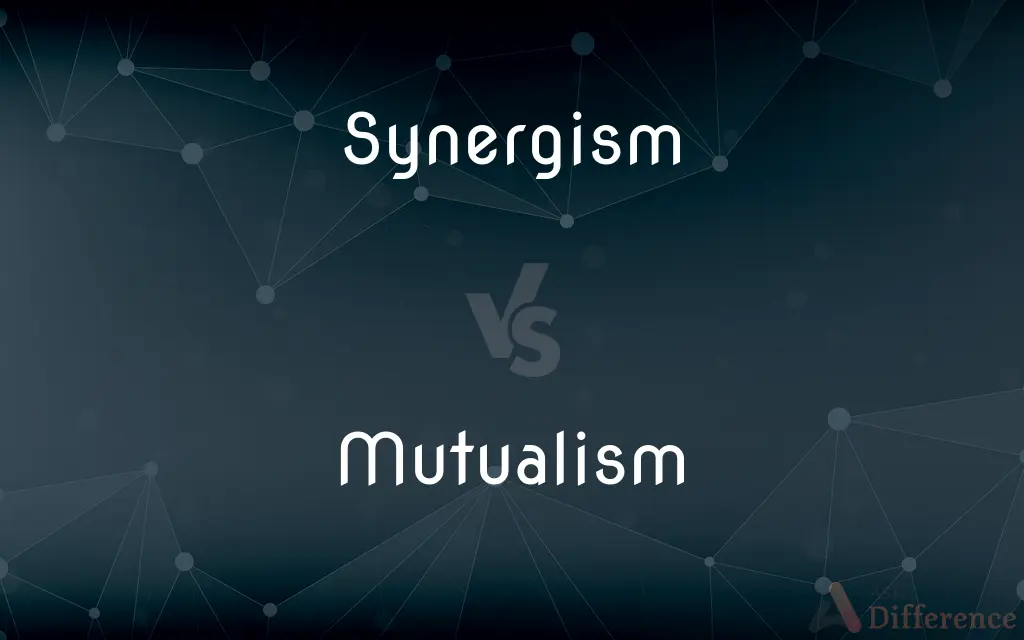Synergism vs. Mutualism — What's the Difference?
Edited by Tayyaba Rehman — By Urooj Arif — Updated on March 31, 2024
Synergism involves entities working together for an enhanced effect, while mutualism is a biological interaction where both parties benefit.

Difference Between Synergism and Mutualism
Table of Contents
ADVERTISEMENT
Key Differences
Synergism describes a scenario where the combined effect of two or more factors is greater than the sum of their individual effects. This concept is broadly applied across various fields such as pharmacology, where drugs may work synergistically to improve health outcomes, and in team dynamics, where collaborative efforts lead to greater achievements. Whereas mutualism specifically refers to a biological interaction between two different species where both parties derive a benefit. This relationship is essential in ecosystems, exemplified by bees pollinating flowers while feeding on their nectar.
In the context of biology, synergism can refer to cooperative interactions within a single organism or between different species that are not necessarily beneficial to all involved parties. For example, bacteria in the human gut can work synergistically to break down food, which benefits the host but not all bacteria may benefit equally. On the other hand, mutualism always involves mutual benefits, such as the relationship between coral and zooxanthellae, where coral provides the algae with a protected environment and compounds necessary for photosynthesis, while the algae produce oxygen and help the coral to remove wastes.
Synergism can occur in non-living systems, illustrating the broad applicability of the concept. Chemical reactions, for instance, can be synergistic when substances interact to produce a mixture with properties superior to those of the individual constituents. Mutualism, however, is limited to living organisms and their intricate relationships that have evolved over time.
While synergism can be temporary or situational, mutualism tends to involve more stable and often long-term interactions between species. For instance, temporary synergistic partnerships may form during collaborative projects among businesses, but mutualistic relationships, like those between ants and aphids, are sustained over longer periods, providing ongoing benefits to both parties.
Synergism emphasizes the enhanced outcome produced by the interaction, focusing on the result more than the nature of the relationship. In contrast, mutualism is defined by the reciprocal benefits shared between partners, highlighting the importance of the relationship itself and its balance of benefits.
ADVERTISEMENT
Comparison Chart
Definition
Interaction of elements for an enhanced effect.
Biological interaction where both parties benefit.
Context
Broad, including biology, chemistry, and teamwork.
Strictly biological, involving different species.
Benefits
May not be equally distributed among participants.
Always mutually beneficial to involved parties.
Occurrence
Can happen in living and non-living systems.
Limited to living organisms.
Relationship Nature
Can be temporary, situational, or long-term.
Typically stable and long-term.
Compare with Definitions
Synergism
Chemical Reaction.
The catalytic converter in cars uses synergism to reduce harmful emissions.
Mutualism
Evolutionary Partnership.
The mutualism observed in lichen represents a successful evolutionary strategy.
Synergism
Economic Synergy.
Merging companies often seek synergism to enhance profitability and efficiency.
Mutualism
Biological Cooperation.
The mutualism between bees and flowers facilitates pollination and food production.
Synergism
Innovation through Collaboration.
Research institutions promote synergism to foster groundbreaking discoveries.
Mutualism
Ecological Interdependency.
Mycorrhizal fungi and plants engage in mutualism, exchanging nutrients for sugars.
Synergism
Collaborative Enhancement.
In teamwork, the synergism among members can lead to unprecedented success.
Mutualism
Symbiotic Relationship.
Clownfish and anemones exhibit mutualism, each offering protection to the other.
Synergism
Pharmacological Interaction.
The synergism between certain medications results in a more effective treatment.
Mutualism
Resource Sharing.
Ants and aphids share a mutualism, with ants protecting aphids in exchange for honeydew.
Synergism
In Christian theology, synergism is the position of those who hold that salvation involves some form of cooperation between divine grace and human freedom. Synergism is upheld by the Roman Catholic Church, Orthodox Churches, Anabaptist Churches and Methodist Churches.
Mutualism
An association between two organisms of different species in which each member benefits.
Synergism
Synergy.
Mutualism
(ecology) Any interaction between two species that benefits both; typically involves the exchange of substances or services.
Synergism
(Christianity) The doctrine that individual salvation is achieved through a combination of human will and divine grace.
Mutualism
An economic theory and anarchist school of thought that advocates a society where each person might possess a means of production, either individually or collectively, with trade representing equivalent amounts of labor in the free market.
Synergism
Synergy
Mutualism
The doctrine of mutual dependence as the condition of individual and social welfare.
Synergism
The theological doctrine that salvation is brought about by a combination of human will and divine grace
Mutualism
The relation between two different species of organisms that are interdependent; each gains benefits from the other
Synergism
The doctrine or theory, attributed to Melanchthon, that in the regeneration of a human soul there is a coöperation, or joint agency, on the part both of God and of man.
Synergism
The working together of two things (muscles or drugs for example) to produce an effect greater than the sum of their individual effects
Synergism
The theological doctrine that salvation results from the interaction of human will and divine grace
Common Curiosities
What is synergism?
Synergism is the interaction between two or more elements that results in a combined effect greater than the sum of their separate effects.
What is mutualism?
Mutualism is a type of biological interaction where both parties involved benefit from the relationship.
Can synergism occur outside of biology?
Yes, synergism can occur in chemical reactions, economic ventures, and collaborative projects.
How does synergism differ from mutualism?
Synergism focuses on the enhanced effect of a combination, not limited to living organisms, while mutualism specifically refers to mutually beneficial relationships between different species.
Can synergism have negative effects?
While generally positive, synergism can have negative effects, such as when drugs interact to produce harmful side effects.
Are all synergistic interactions long-term?
No, synergistic interactions can be temporary, situational, or long-term, depending on the context.
What are some examples of mutualism in nature?
Examples include the relationship between pollinators and flowers, and symbiotic relationships like those between clownfish and anemones.
Why is mutualism important in ecosystems?
Mutualism is crucial for the stability and sustainability of ecosystems, promoting diversity and interdependence.
Is mutualism always beneficial to both parties?
Yes, in mutualism, both parties involved receive benefits that are crucial for their survival or well-being.
Can a relationship be both synergistic and mutualistic?
In some contexts, relationships can exhibit both characteristics, especially in complex biological interactions.
How does mutualism affect biodiversity?
Mutualism can enhance biodiversity by fostering interdependent relationships that support a wide range of life forms.
How do humans benefit from understanding synergism?
Understanding synergism can lead to advancements in medicine, technology, and environmental conservation.
Share Your Discovery

Previous Comparison
Near vs. At
Next Comparison
Typescript vs. ManuscriptAuthor Spotlight
Written by
Urooj ArifUrooj is a skilled content writer at Ask Difference, known for her exceptional ability to simplify complex topics into engaging and informative content. With a passion for research and a flair for clear, concise writing, she consistently delivers articles that resonate with our diverse audience.
Edited by
Tayyaba RehmanTayyaba Rehman is a distinguished writer, currently serving as a primary contributor to askdifference.com. As a researcher in semantics and etymology, Tayyaba's passion for the complexity of languages and their distinctions has found a perfect home on the platform. Tayyaba delves into the intricacies of language, distinguishing between commonly confused words and phrases, thereby providing clarity for readers worldwide.
















































